Living photonic crystals
G. I. Márk1,
K. Kertész1,
Zs. Bálint2,
Z. Vértesy1,
Z. E. Horváth1,
J. Balázs1,
D. Méhn3,
I. Kiricsi3,
V. Lousse4,
J. -P. Vigneron4,
L. P. Biró1
1
Nanotechnology Departement
,
Research Institute for Technical Physics and Material Science
,
1121
Budapest, Konkoly Thege Miklós út 29-33, Hungary
2
Hungarian Natural History Museum,
1088 Budapest, Baross utca 13, Hungary
3
Department of Applied And Environmental Chemistry
,
University of Szeged,
6720 Szeged, Rerrich Béla tér 1, Hungary
4
Laboratoire de Physique du Solide
,
Facultés Universitaires Notre-Dame de la Paix
,
61 rue de Bruxelles, B-5000 Namur, Belgium
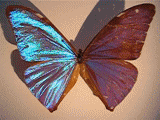
Click on the image to see an Indeo compressed AVI animation (1.3 M)
Introduction
Photonic crystals are periodically structured dielectric media,
generally possessing ranges of frequency in which light cannot
propagate through the structure (photonic bandgap). This periodicity,
whose lengthscale is proportional to the wavelength of light in the
band gap, is the electromagnetic analogue of a crystalline atomic
lattice.

|
|
Butterfy wing structure in different magnifications
|
Efforts for producing artificial photonic crystals are motivated by
possible applications in optical filtering and optical computing, or in
the design of very compact lasers, and by phenomena such as the
spectral manipulation of light by shock waves.
However, photonic-crystal-like structures have been developed in several species
of butterflies and beetles during their evolution.
Discoloration
Lycaenid butterfly populations in mountainous regions at altitudes of
2000-2500 m show an interesting phenomenon described by Balint and
Johnson in 1997, called discoloration. Males of these populations do
not show bright structural coloration on their wings, (like low
altitude ones) but they have the warm brown color typical of females.

|
Geographical origin of blue and brown butterflies
|
Electron microscopic investigation of two male butterflies (Polyommatus
daphnis - low altitude, and Polyommatus marcidus - over 2500 m Elbrus
Mountains) revealed that the blue color can be attributed unambiguously
to the fine, spongelike medium, called by the entomologists
pepper-pot structure present between the ridges and the cross ribs in the
scales of the colored butterfly. Only traces of this structure can be
found on the scales of the discolored butterfly.
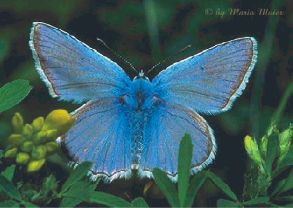
|
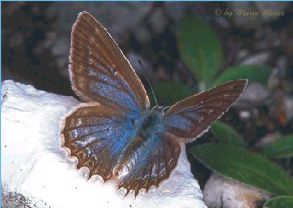
|
A blue butterfy
|
A brown butterfly
|
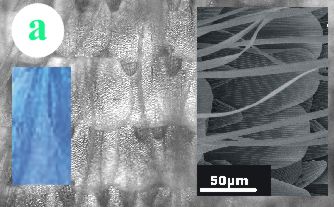
|
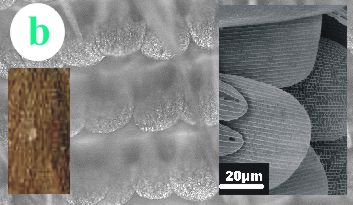
|
Blue butterfy scale structure
|
Brown butterfly scale structure
|
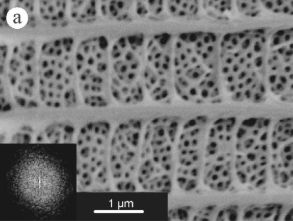
|
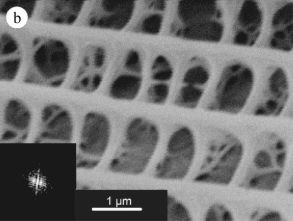
|
SEM image of blue wing. Inset:
FFT power spectrum
|
SEM image of brown wing. Inset:
FFT power spectrum |
Thermal measurements
The explanation given to the phenomenon of discoloration is based on
the thermal-regulation mechanism of butterflies. Males emerge several
days earlier before the emergence of females for setting up perching
area. Prior to their early morning activities, they have to spend
considerable time to heat their bodies using the energy of solar
radiation. The discolored males are able to use in a more efficient way
the energy of the sunlight, therefore they have better survival rates.
To verify this hypothesis, we measured the temperature difference
between the identical illuminated blue and brown wings. The ratio of
butterfly wing temperatures compared to white paper was calculated
according to the equation

where TBR(Pi), TBL(Pi) and
TWH(Pi)
are the temperatures of brown, blue wings and white paper, and Pi
is the incident light power.
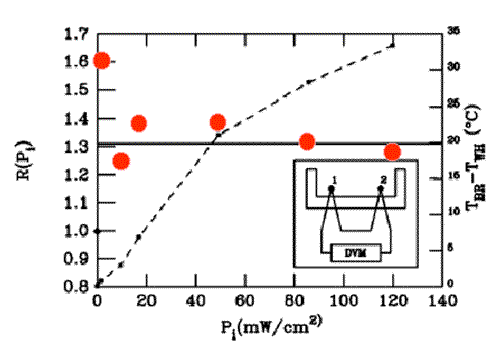
|
|
R(Pi), and temperature
difference between the brown wing and white
paper. As inset, the experiment setup. |
Optical measurements
The transmission spectra shows that practically all the UV-VIS light
incident on the upper wing is either absorbed by the wing or
reflected by the scales both for the blue and the brown butterfly.
Comparative specular reflectance measurements between the wings were
carried out at 27,5o. One may remark a significant
difference around
490 nm with an extended shoulder towards the red region. The
differences in the reflectance then indicate that, due to the smaller
reflectivity of the brown wing, this sample is absorbing a larger
amount of energy.

|
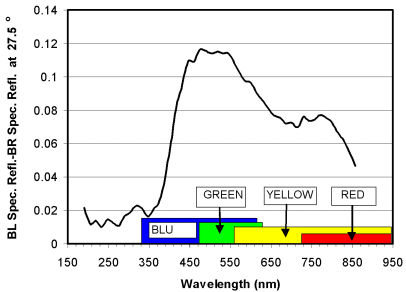
|
Transmission spectra of the blue
(continuous line) and the brown (broken line) butterfly wings.
|
Specular reflectance difference
of the blue and brown male butterfly wings, measured at 27.5°. The
spectral regions in which the colored glass filters have a transmission
higher than 50% are indicated.
|
In support of the interpretation of the reflectance data, a computer
model was build and reflection coefficients computed. The theoretical
structure consists of a stack of four ordered layers with 0,2 mm
thickness. Each of the chitin walls are 0,066 mm thick, with refracting
index of 1,5. This structure provides the theoretical result shown as a
solid line. The dotted line refers to a variant model. In this case the
parallelepipedic cavities have been replaced by hollow ellipsoids. The
convergence of the results provided by these models, confirms that the
coloration spectrum most likely originates from the pepper-pot
structure.

|
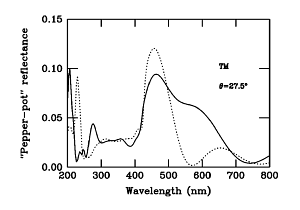
|
|
Model structure built on the basis of high-resolution
SEM images used in the computer simulation of the photonic crystal.
|
Reflectance values (solid line) of the pepper-pot structure
as calculated from the computer model.
The dotted line refers to a second, independent model,
where parallelepipedic cavities are replaced by ellipsoids.
|
Conclusions
The pepper-pot structure acts as a natural photonic band gap (PBG)
causing the increased reflectance in the spectral range from blue to
near UV.
Beyond their applicability in optical devices, PBG materials may find
useful applications in thermal management too.
The pepper-pot structure is far from being as perfect as artificially
produced PBG materials, it is likely that the manufacturing conditions
are less strict for these materials to be used in thermal applications.
Acknowledgments
The work in Hungary was supported by OTKA grant T 042972.
References
Biró, L., P.; Bálint, Zs.; Kertész, K.; Vértesy, Z.;
Márk, G., I.; Horváth, Z., E.; Balázs, J.;
Méhn, D.; Kiricsi, I.; Lousse, V.; Vigneron, J.-P.:
Role of photonic-crystal-type structures in the thermal regulation of a
lycaenid butterfly sister species pair;
Phys. Rev. E 67, 021907-1(2003).
http://www.mfa.kfki.hu/int/nano/reprint/pre_67_021907_butterfly.pdf
http://ojps.aip.org/getabs/servlet/GetabsServlet?prog=normal&id=PLEEE8000067000002021907000001&idtype=cvips&gifs=Yes
Last updated: June 28, 2004
by Géza I. Márk , mark@sunserv.kfki.hu
This page was accessed  times
since June 28, 2004.
times
since June 28, 2004.















